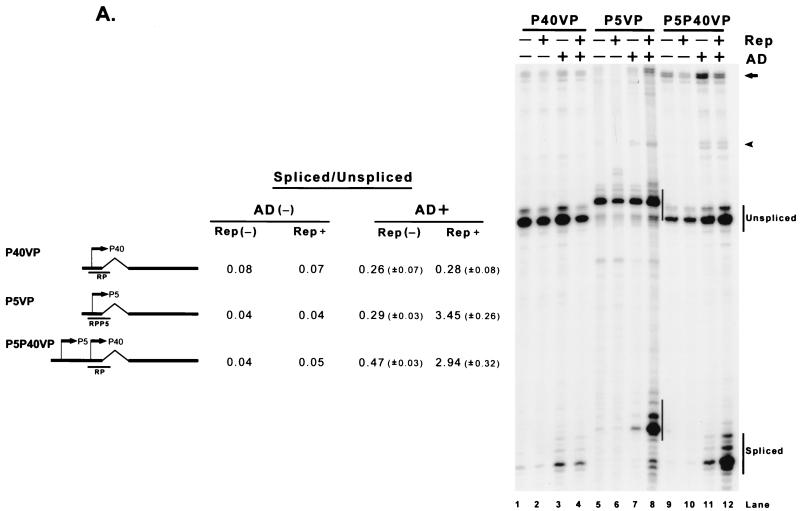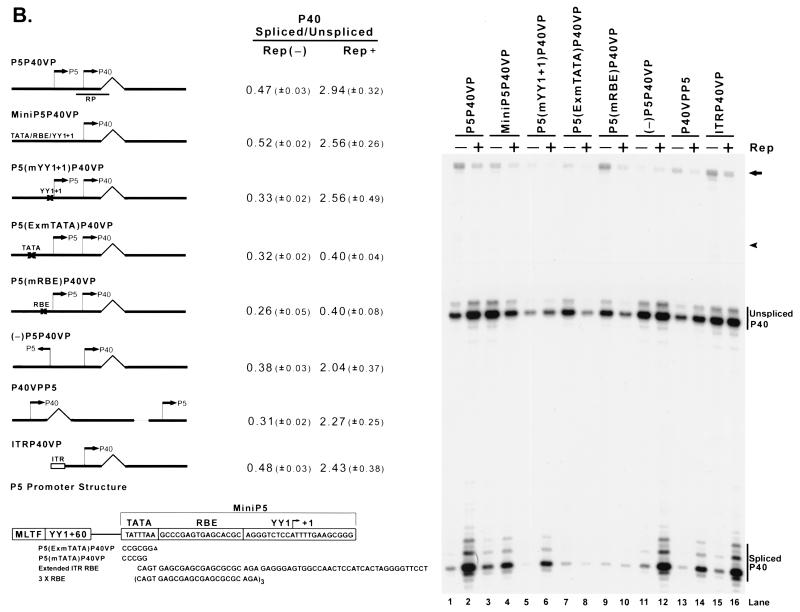FIG. 2.
The AAV Rep proteins, when targeted to the transcription template, can enhance the ratio of spliced to unspliced AAV RNAs. (A) 293 cells were transfected with plasmid P40VP (lanes 1 to 4), P5VP (lanes 5 to 8), and P5P40VP (lanes 9 to 12) with (Rep+) or without [Rep(−)] cotransfection of the Rep supplementation plasmid RepSM in the absence [AD(−)] or presence (AD+) of adenovirus (MOI, 10). Ten micrograms of total RNA from transfected cells was protected by the homologous probes RP (lanes 1 to 4 and 9 to 12) and RPP5 (lanes 5 to 8), which are depicted under their respective plasmid diagrams on the left. Spliced and unspliced RNA specifically initiated from either the P40 (lanes 1 to 4 and 9 to 12) or P5 (lanes 5 to 8) promoters in a representative experiment is shown and labeled on the right. Quantitations of the ratio of spliced to unspliced RNAs for the intron-proximal promoters are shown and are averages of the results of at least three separate experiments, with standard deviations in parentheses. For quantitations in the absence of adenovirus, all standard deviations were <0.01. For the P5P40VP construct, a portion of the bands shown by the arrow and arrowhead reflect unspliced and spliced RNA generated from the P5 promoter, respectively (lanes 9 to 12); in the other lanes, these bands are assumed to derive from low levels of plasmid read-around transcription. (B) Mutant constructs, as described in the text, are shown. An X in the plasmid diagrams is used to show the location of some of these mutations. 293 cells were transfected with (+) or without (−) Rep supplementation by RepSM in trans in the presence of adenovirus. Harvested total RNA samples were protected by the RP probe, and the unspliced and spliced RNA bands specifically initiated at the P40 promoter of a representative experiment are indicated on the right. Quantitations of the ratio of spliced to unspliced P40-initiated RNAs are shown and are the averages of the results of at least three separate experiments, with standard deviations in parentheses. For the experiment shown in lanes 1 to 10, the portions of the bands shown by the arrow and arrowhead reflect the unspliced and spliced RNAs generated from the P5 promoter, respectively; in the other lanes, the bands are assumed to derive from low levels of plasmid read-around transcription. The structure of the AAV P5 promoter is shown at the bottom of the diagram. The sequence shows the mini P5 element (used in MiniP5P40VP), which confers Rep responsiveness to the transcription template (lanes 3 and 4). The boxed region indicates sequence elements previously characterized to bind YY1, MLTF, and TBP and also the RBE. TATA mutations that either abolish Rep responsiveness [P5(ExmTATA)P40VP; lanes 7 and 8] or have no effect on this function [P5(mTATA)P40VP; see text] are depicted.


